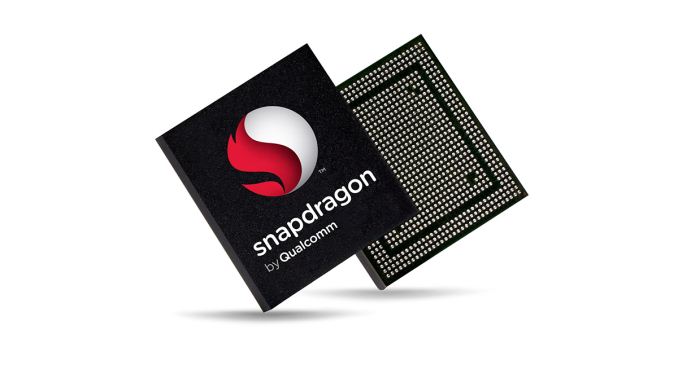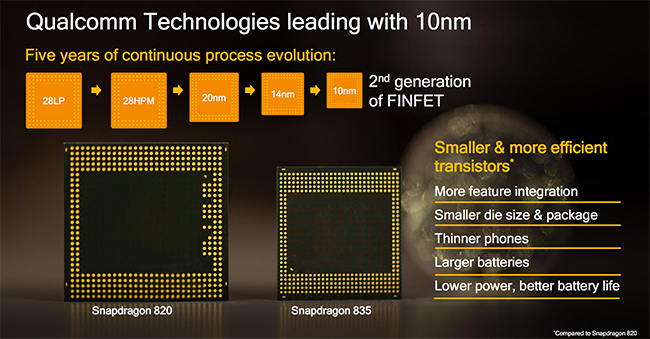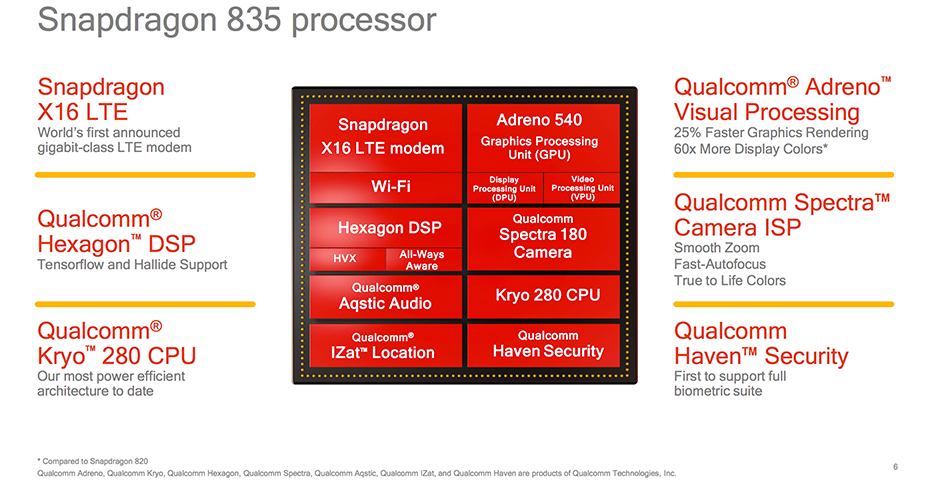Qualcomm Details Snapdragon 835: Kryo 280 CPU, Adreno 540 GPU, X16 LTE
by Matt Humrick on January 3, 2017 5:00 PM EST- Posted in
- Smartphones
- Snapdragon
- Qualcomm
- Adreno
- Mobile
- Snapdragon 835
- Kryo

Qualcomm previously revealed the name of its new high-end SoC, but today at CES 2017 it discussed the Snapdragon 835 in greater detail. Replacing the Snapdragon 820/821 as the pinnacle processor in its lineup, the 835 is the first commercial SoC to use Samsung’s 10nm "10LPE" FinFET manufacturing node. Qualcomm did not disclose die size, but it said the overall package size is 35% smaller than the Snapdragon 820 and contains more than 3 billion transistors. Samsung says its third-generation FinFET node “allows up to a 30% increase in area efficiency with 27% higher performance or up to 40% lower power consumption” relative to its first-generation 14nm 14LPE node at the same frequency, so Snapdragon 835’s process advantage over the 820, which uses Samsung’s second-generation 14LPP node, will be a bit less.
In addition to smartphones and tablets, Qualcomm sees the 835 powering IP cameras, VR and AR head-mounted displays (it has a reference HMD design available for partners and says several products are currently in development), and even new ultra-portable cellular PC devices with full Windows 10 support. This includes both Universal Windows Platform (UWP) apps, which run natively, and legacy x86 (32-bit) Win32 apps, which use software emulation. These new PC devices should also support any peripherals already supported by Windows 10 and eSIM support for cellular connectivity.
Qualcomm finds itself in a much different position today compared to one year ago when it launched the Snapdragon 820. Back then, it was on the hot seat after its previous flagship products, the Snapdragon 808 and 810, failed to meet expectations. Qualcomm’s implementation of ARM’s Cortex-A57 CPU core and TSMC’s last 20nm planar process were not a good combination, resulting in a generation of flagship phones that struggled to meet or exceed the performance of older models and exhibited higher than normal skin temperatures. The success of Snapdragon 820 would be crucial to regaining its partner’s trust and restoring its image with consumers.
The 820 was pivotal for another reason too: It introduced Qualcomm’s first custom 64-bit CPU core, Kryo. Creating a custom CPU (or GPU/DSP/ISP) is one way for SoC vendors to differentiate their products and establish themselves as innovators. Snapdragon 810’s use of stock ARM cores could be construed as a step backwards then after previous Snapdragon SoCs used Qualcomm’s custom Krait CPUs. Apple’s prior introduction of a custom 64-bit CPU, which caught everyone by surprise, only added fuel to the fire.
The Snapdragon 820 would go on to become a commercial success with many design wins. It powers the majority of flagship phones released over the past year, and while Kryo trails ARM’s A72 and Samsung’s M1 CPUs in IPC, it performs well enough to deliver a solid user experience.
With today’s launch of Snapdragon 835, Qualcomm looks to build on the 820’s success and its vision for the future: heterogeneous computing. By combining the unique abilities of each processor type—CPU, GPU, and DSP—Qualcomm hopes to bring new features and experiences, such as VR and machine learning, to mobile devices.
The 820 introduced several key features that form the foundation of this vision, which is why it’s so important to our discussion of the 835. Its Hexagon 680 DSP added single instruction, multiple data (SIMD) Hexagon Vector Extensions (HVX) specifically aimed at accelerating the aforementioned VR and machine learning workloads, along with more efficient processing of photography and computer vision tasks. The Adreno 530 GPU’s compute capabilities received a boost too, and the GPU and CPU gained the ability to snoop into the other’s cache using shared 64-bit virtual memory addressing, enabling better sharing of data. Qualcomm also introduced its Symphony System Manager alongside the 820 to provide task scheduling and power management for the various processor cores.
The Snapdragon 835 is more evolutionary than revolutionary by comparison. Every block within the new SoC receives an update, however, enabling new features and claims of higher performance and better battery life. With the backstory complete, it’s time to discuss these changes in more detail, starting with the biggest change of all: the CPU.













58 Comments
View All Comments
prisonerX - Wednesday, January 4, 2017 - link
Open your eyes and you shall see: http://www.gsmarena.com/lg_v20-8238.phpNo, no-one wants to carry a fat phone, that's why phones aren't getting fatter with substantially larger batteries. What don't seem to be able to understand is most people are happy with battery performance.
Yeah, 4000-5000 is the magical number, if only phones had that no-one would run out of power, right? No one wants to carry around extra batteries but they want to carry around external battery pack chargers, right? You've really thought this through, haven't you?
darkich - Thursday, January 5, 2017 - link
There are many reasonably compact and well specced phones with large batteries. Check out this newly announced Asus phone, Zenfone 3 Zoom: 5000mah in a small package!jospoortvliet - Thursday, January 5, 2017 - link
There is one. But because nobody bought the LG G5 it won't be there next year. Clearly nobody wants a high end phone with removable battery, including YOU otherwise you had bought it...Spunjji - Saturday, January 7, 2017 - link
That phone had SO MANY things wrong with it, none of which had anything to do with the removable battery. All you did there is prove the point that we don't get to choose the features we want, just the best collection of them.niva - Wednesday, January 4, 2017 - link
In general they are right though. We've passed the point of reasonable thin-ness. Now as far as design goes the only things to fix are addressing the size of ridiculous bezels around the screen, making these things sound better, and making sure they actually have sufficient battery life to accommodate junkies who only look at their phone screens all day long.Note that Apple devices seem to have a good balance of all of the above. My prediction is that the first manufacturer to offer a flagship android phone with this balance will pocket a good chunk of change. Unfortunately Android is also marred by other issues such as fragmentation and lack of updates from manufacturers, so it's not so simple.
leexgx - Tuesday, January 10, 2017 - link
same here I never change the battery they should come with a larger battery to begin with (especially if its a none removable one) problem is most phones that have large battery or under powered on the CPU (CUBOT H1 that I use or less so the Ulefone power phone but the cam button is in stupid place so I don't use it)phones should come with at least a 3500-4000mAh in these high powered CPU phones and high powered screens (what I hate is that they get a more power efficient CPU and clock it as high as they can witch does not save any more power then last phone and turns into a toaster like 820 cpu)
best non modified phone I ever had was the motorola RAZR MAXX even after 5-6 years of use it still lasted near 2 days on full charge (a smashed screen and finally water damage killed it, not the battery) at the time it was like OK I am now at 10-20% power okkk I just stop streaming video , norm still good for a bunch more hours
I believe LG has made a Power version of the phone but still not very good spec, why cant they just use a feature phone and make it 2-3mm fatter you be surprised how much longer a phone lasts when it has a 1000-1500 above spec battery that a phone maker stupidly assumes you need get by a day on one charge witch tends not to be a day (under 3000mAh seems to be the limit now for a usable phone now
vferg - Monday, February 20, 2017 - link
I would agree with you if I was still stuck on my 2 year old phone but honestly since trying out 2 phones for the last 6 months with USB C and quick charge I haven't worried or thought about battery like I used to anymore. Between the faster charging, the optimized lower power usage with the newer CPU's, and the OLED screens they come on I normally get about a day and a half with normal use before I need to charge. The phones just 2 years ago though I needed to charge twice a day. I was always for pumping a bigger battery but if they are maintaining a day and a half right now I don't mind them keeping it as is for the moment.R3MF - Tuesday, January 3, 2017 - link
HSA?melgross - Tuesday, January 3, 2017 - link
This is a nice article and all. But whatever happened to the deep dive we were promised about the iPhone A10 for late OCTOBER? I've looked all over for it. I'm here several times a day, and never saw it.ddriver - Tuesday, January 3, 2017 - link
October is 10 months away doh ;)